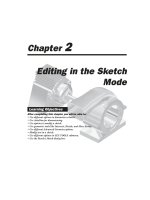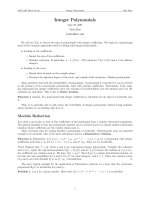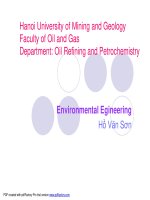BPTCTC bang tieng anh
Bạn đang xem bản rút gọn của tài liệu. Xem và tải ngay bản đầy đủ của tài liệu tại đây (65.32 KB, 9 trang )
CHAPTER II
EXECUTION METHOD
I.
MATERIAL AND PLAN PREPARATION
1. Line reception
After receiving standard altitude poles as designed, our Company will measure those poles
again, specifying significant items to commission poles, drive the heart pole and necessary
supporting poles for execution in special positions such as to change inclining level for curve
segments, junctions of dug parts and use pole method.
2. Transportation
2.1.
Long way transport
Material electric devices are conveyed by 5 – 10 ton trucks from warehouse of the
Enterprise to the site, insulation of all kinds must be secured to avoid damages. Such materials as
conductor, insulator, accessories, etc. are conveyed along the line during the execution period.
2.2.
Line distributive transport
- Cement, timber boards, steel, execution tools, rails, porcelains, conductor, accessories, etc. are
distributed along the line by simple vehicles.
- Sand and rock are conveyed along the line by simple vehicles.
2.3.
Manually conveyance to execution positions
- All material after being gathered in execution positions is conveyed manually with simple
vehicles.
* Pole conveyance
-
In positions with easy plan and conveying paths, we can use pole conveying specific tire
vehicles.
In hard positions, we can apply the method of pulling poles manually: robes and pulleys (in
special inclining positions):
+ If the conveying path foundation is field land without rocks and in short distance (less than 40
m) we can pull poles directly sliding along the land surface.
+ In positions of long distance or over a hard land foundation or rocky land, we have to use
pile supporting parts in conveying to avoid piles from directly contacting with land surface as
pulling.
* Conveying conductor to right positions
It is necessary to indicate where to put conductor reels reasonably: near car way with
relatively flat topography and convenient for conveying conductor reels.
-
Put conductor reels on to trestles, use pulleys to pull those reels to right positions.
* Conveying accessories
-
Rails, stays, earthing wire and accessories are carried on shoulders or conveyed by self-made
conveyors.
Accessories are carried manually with containers or packages, etc.
* Conveying sand and rock manually
-
Prepare material gathering place: When digging pole foundation, we have leveled the plan of
sand and rock gathering positions. Each kind of material is heaped separately, lined by 16-25 m 2
wide plastic canvases (depending on material mass), absolutely no material is put on soil surface.
* Conveying bamboo trees and timber lining boards
Bamboo trees and timber lining boards are carried on shoulders to its indicated positions.
After dissembling, and bamboo are used in other positions.
* Conveying cement bags.
Cement is carried and put near the foundation holes with calculated quantity. It is necessary
to prepare cement covering canvases in case of sudden rains.
* Conveying construction water
Construction water is taken from clean water sources such as rivers or ponds or lakes near
the execution spot and conveyed manually by simple vehicles.
* Conveying execution tools
-
Handheld execution tools: shovels, hoes, levers and hammers, etc. are brought along by workers
as they get into working positions.
3. Construction compensation and construction plan
a. Foundation construction plan
The foundation construction plan includes foundation hole digging area, earth dumping
area, the earth dug up is leveled and become the foundation construction material gathering
place.
b. Pile erecting construction plan
There will be personnel assigned to clear conveying plan and pile gathering plan, clear and
tidy up conveying paths, pile storing plan, alternative hole position of pulleys and supporting
robes.
c. Construction plan for wire straining and distribution
There will be personnel in charge of compensation assigned to clear the plan, clear the
space along the line, alternative hole position, machine pulley positions, wire reels positions.
4. Construction power and water
- Construction water must be clean water from ponds and tape water of residents along the
line.
5. Vehicles, machines and construction devices
Based on working mass and construction progress, our Company will arrange specialized
vehicles, machines and construction devices with maximum quantity and best quality in order to
complete the construction early, reducing supervision time for the investor. The number of
vehicles, tools and construction devices are brought to the construction spot (attached list).
6. Promoting material supply progress and improve material quality
- When the plan is ready, our Company, based on design documents, shall timely sign
contracts with material suppliers in order to promote the material supply progress in spot.
7. Improving construction quality
- Arrange professional training, norms and procedure teaching, apply reasonable
construction method, combining manual parts and machinery parts.
- Apply random cross testing among construction units, especially facilitate the Supervisor
A to frequently present in spot to check and give close comments in case of violation.
II. Foundation construction method:
1. Preparation
After commission the line, start preparing the following:
-
Review the line, foundation positions, line direction, compare actual tested factors with factors in
passed design documents to as-build the line
2. Check and recover the base heart, as built as- build the line
Based on the commissioned base heart by investor, start to check neighboring
constructions and other factors impacting on this construction. Check line heart axes, bone and
base heart, pillars of the foundation to limit the hole plan and hole depth. Base heart must be
guided to the surrounding of the hole, marked by wooden piles of dimension 40x40x300mm and
protected from soil covering or people stepping up. In special positions such as inclining level
changing positions or the curving junction between digging parts and dap parts there must be
more necessary supporting piles.
3. Earthworking
+ Actual foundation transfer
Use the surveying machine system and steel rulers to guide standard bone to the foundation
digging area and form up the framework according to the base hearts commissioned based on
data and design drawings by geometric method.
+ Foundation transferring method: indicate the width A (distance from feet of
correspondent steel piles) of pillar hearts, the width B of the foundation hole (B= pillar base
width + 0.3m), afterwards, build foundation hole dimension indicating piles before digging.
During digging, base on standard bones frequently to check the depth of the hole.
III. Concreting
a.
b.
Formwork and false-work
Steel foundation molding lining boards must meet the following technical standards:
Made from steel.
Sufficient in size in order to mold foundation blocks as designed.
Material:
All material provided for the construction such as sand, gravel, steel, etc. must be cleaned
before conveying to the spot.
c. Concrete mixture:
+ Mix the concrete by machines following technical process properly.
+ Cement, sand, macadam and water for concrete mixing must be measured to right rate
for each mixture according to mixture level.
+ If concrete is mixed by machine, material is put into the machine in the following order:
d. Concreting and concrete tamping
+ Concreting is carried out on the principle:
Not slanting the steel core position, lining board position and the thickness of the steel core
protecting concrete layer.
Concrete is continually poured until a structure is completed as design require.
+ the height of pouring the concrete mixture must not exceed 1.5m. If it is more than 1.5m,
use inclining spouts. As using spouts, it must be smooth enough, wide more than 3 – 3.5 times of
the biggest bone drain diameter. The inclining level of the mang must ensure the concrete
mixture not to stuck, not to slide too fast causing layering phenomenon.
e. Concrete maintenance.
After 24 hours of dissembling lining boards, maintain the concrete as follow:
+ In summer condition, after dissembling the lining boards, cover the concrete surface
before evenly watering the whole covering and concrete, after 2 hours, do it again. The concrete
must be maintained for at least 7 days.
IV. Erect the poles.
-
When erecting the pole of 16 – 20 mm, use 14m tripod, 5- 10 ton chain pulleys or machine
pulleys.
The pole foundation after concrete is 21 days old or more and mutually commissioned by A-B
before erecting.
*, Pole erecting method with tripod
- Erecting tool: tripods, 5 ton pulley, hanging cable, pole tying cable, fixing cable to fix
tripod top of 12mm diameter, nylon string, lever, etc.
-
Erect the tripod: the tripod must be put on the plan of the pole foundation, at 3 points of a equal
triangle, the tripod tops are linked together by specific locking chuck.
* Requirements as erecting the pole
As erecting poles, comply strictly technical process, especially in safety. Specifically,
-
-
Workers who erect poles must have professional skills and be trained technical process. Leaders
must be professional personnel or worker of level 5 or higher. The remaining main workers must
be at level 3 or 4.
Supporting workers must be trained in order to be aware of the process.
-
Preparation for erecting poles must be careful, tying nodes, joints, chucks, alternative holes,
pulley restrictors and erecting tools must be checked carefully, especially the straining cable if it
meet technical standards.
V. INSTALL STEEL RAILS AND INSULATION PORCELAINS
1. INSTALL STEEL RAILS
- Steel rails are steel structures installed manually, the X rail is installed in height (after
erecting poles), other rails are installed right as they are laying on the surface in order to reduce
construction time, as installing, check the straightness of the rail by squares, check the tightness
of rails, bolts, screws, there must be spring washers to avoid self loosing, stay rails must be
installed in line with … line of the stay angle.
2. INSTALL INSULATION PORCELAINS
- Insulation porcelains must be cleaned and checked for broken parts before installing.
- For series porcelains, we must check washers and use round socket tools in the right way.
VI. STRAIN WIRE
* Requirements
- All poles are commissioned to change construction step.
- Line corridor has been cleared before straining wire.
- The whole workers have been test of safety and mastered detailed construction solution.
-
Only strain wire after all pole screws are tightened as required. The pole earthing part is fastened
and has the right value.
1. Preparation
- Indicate where to put wire reels. It should be put on sustain land, easy for trucks to go in or out,
or lifts wire and suitable with the stay distance and length of the wire reel so that there will be
least connection for more economical.
- Place to put wire straining machine: regularly after the stay pile at the end of a wire straining
segment. Put on solid land. If the land is weak, we can use alternative hole system to change the
direction of wire straining.
2. Execution order
- Arrange tools, construction machines according to the solution.
3.
-
Hang pulleys, build frames supporting wire across traffic roads.
Distribute wire strain manually.
Fix stay locks
Strain wire
Pull conductor from its reel about 3 to 5 winds. Check the signal system to prepare for straining
wire. If the signal is thorough without any interference to strain.
- As straining, if wire slides abnormally, check for information if there is any stuck. If there is any
problem, stop the pulley and fix it before continuing.
4. Pull wire and check inverting level
- After left hanging, the preparation in stay position is done, pull wire gradually, prepare to check
its valley
- Tie checking ruler: At the 2 piles of the distance, checking piles according to the design, tie
checking ruler
- follow the principle pull – loosen – pull, until the wire is stable, the lower valley is on the
checking plain at every checked distance.
CHAPTER IV
CONSTRUCTION QUALITY ENSURANCE METHOD
I.
Technical requirements and standards used during the construction and commissioning:
During the construction, always comply with technical requirements of the bid documents.
Ensure the quality inspection according to the construction quality management decision
according to Decision 109/2004/ND-CP dated December 16th, 2004 and Decision number 12,
dated July 15th, 2005 by Ministry of Construction instructing construction quality management,
etc.
II.
Quality management method:
Quality management method is very important to ensure the construction meets technical
requirements and highest quality, ensuring construction progress:
*, Material and devices:
- All material and devices are received, unloaded, stored and conveyed carefully, safely,
supporting the best for the construction.
*, Human labour in the project:
- in terms of executing labour force, our Company arranges personnel standing by in
Presentative Board to execute the project.
- Leaders, supervisors have many years of experience, capable to lead big construction
project.
CHAPTER V
LABOR SAFETY AND SECURITY SOLUTION
I.
-
Explosion prevention solution:
We always instruct and train technicians and workers to follow statutes and regulations.
We apply standards, regulations on construction. Regularly instruct our staff to handdle, check
and promote in stores and tends in spot.
II. Labor safety solution:
1. General requirement:
All staff participating the construction is train labor safety and certificated by MOLISA.
-
Comply with construction techniques: TCVN 5308 – 1991.
Workers are equipped sufficient working. Workers working in height are medically
checked and equipped with safety string before going to work.
2. Regulation on construction plan:
- In crossing and leading spaces, there must be warning signs to avoid unrelated people
from entering.
3. Regulation on construction tools, vehicles and machines:
a. In terms of construction machines:
We use existing machines of our company, before put them in use, we check the
machines and operator skill, and instruct the operator to master the machines before
starting his work.
b. In terms of tools:
- Handheld electrical or pressure gas tools are checked, maintained and stored carefully
and timely repaired, ensuring safety during being used.
c. For operators:
Machines operators are not allowed to go out or let others be in charge as operating
the machines.
III. Security solution:
-
Make a list of all staff working in spot in order to register temporary resident
procedure with local security and authorities.









